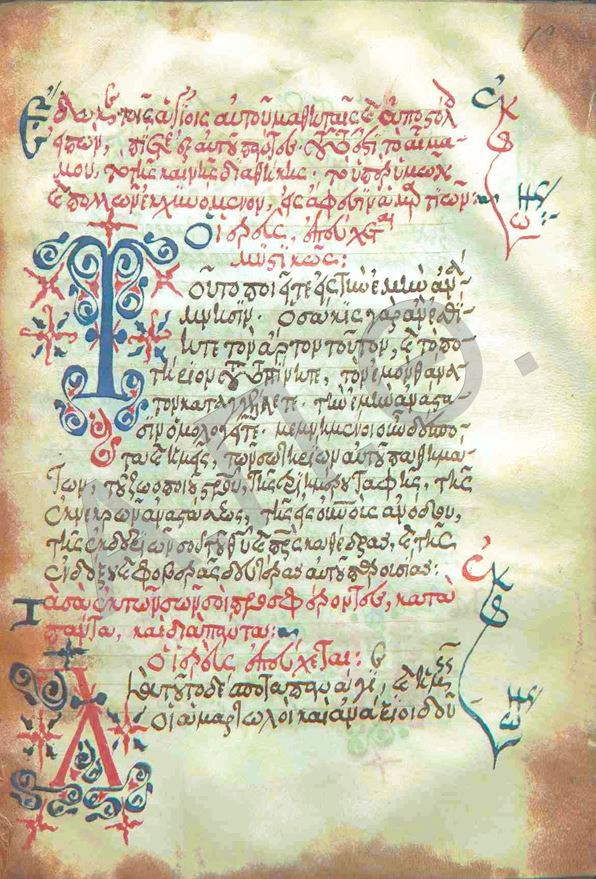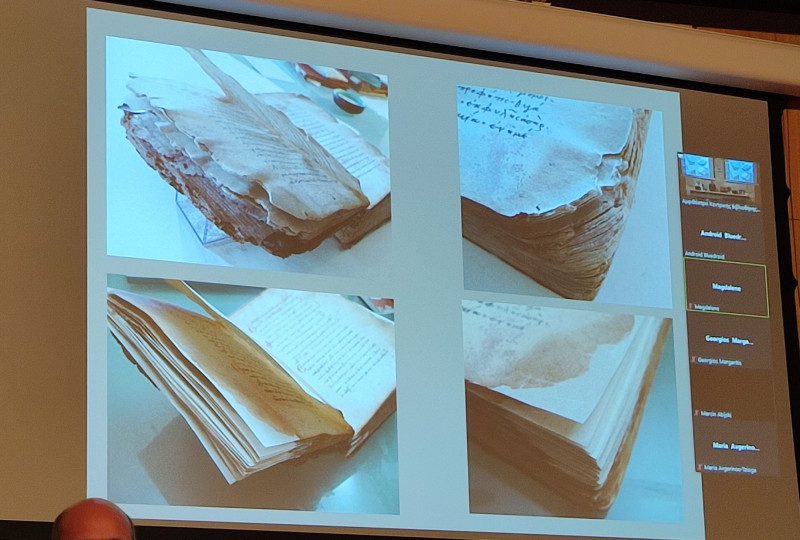Aristotle University Library preserves and saves a rare and valuable collection of Byzantine and post-Byzantine manuscripts
Liturgical, theological, historical, theatrical and literary manuscripts, Greek and foreign languages, as well as a scroll – a manuscript wrapped around a shaft, constitute among others the subject matter of the collection.
Most of them are written on paper, but parchments are also quite a lot.
113 manuscripts are mentioned in the catalog of Linus Politis, but the discovery of newer ones after the publication of the Catalog significantly increases this number.
In the 10th AD century dates back to the oldest fragment of a manuscript owned by the Central Library of the Aristotle University of Thessaloniki and the 12th century. the first Code.
“”For example manuscript 95 has within it thirty-two different splits (i.e. individual leaves from codices of different manuscripts). Manuscript 94 has eight entries and manuscript 99 has two entries. At the moment, there are 183 items in the Collection but we are constantly finding new manuscripts and this number has already exceeded 350. We don’t know where the number will end up, because the process is ongoing”, said Antonis Hatzichristos, from the Office of Palaeography and Codification of the Central Library of AUTH.
The Central Library of AUTH has set up a special area for the study of these manuscripts in its scientific reading room, which has soundproofing, special tools for palaeographic research, such as baridic chains, leaf-changing blades, special pillows, as well as special lecterns, in which the documents are deposited, when a researcher needs to study them.
The manuscripts in the AUTH collection are historical objects, which have a purely scientific use, as the set of texts they contain are often not known to the general public.
Preservation of manuscripts damaged by insects, fungi or rodents
In 2007, the administration of AUTH began the process of conserving the manuscripts of its Central Library collection. Some of them were in good condition and therefore needed little work, but there were manuscripts that were in average condition, but also some that were in poor condition.
“If one wanted to summarize the reasons why a manuscript reaches a state in need of preservation, this could be done using the word loss. Loss of the writing substrate – i.e. leaves or parts of them, which have been cut off or lost due to other factors, such as the intense growth of fungi, damage from rodents and also insects”, pointed out the art conservator of the Museum of Byzantine Culture Giorgos Boudalis, who he was one of the six conservators who, after open tenders, undertook this project.
Conservation was done on about a hundred manuscripts, based on modern standards. “We try – as far as possible, to add as few things as possible to a manuscript, because our experience has shown us that many of the materials with which we think we have made a manuscript and saved it over time, create much more problems. For example, there are man-made damages, one of which is the operation with cello tape, which over time oxidizes and the glue passes through the paper”, stressed Mr. Boudalis.
Preservation of manuscripts with… notes from predecessors
The preservation of manuscripts, according to Mr. Boudalis, is as old a job as the manuscripts themselves. “What we have observed, and personally fascinates me, is a manuscript on a parchment that has a tear and someone tried – very effectively – to hold it together with a fine thread and a knot. It could be paralleled with an operation, as we do with suturing a human wound. The comparison is not accidental. The parchment is also a skin, of course not alive like the human skin, but let’s not forget the relevance that books and people have on a linguistic metaphorical level, since it is no coincidence that in both cases we are talking about …body”. he said characteristically.
Another type of manuscript conservation intervention from the Byzantine and Post-Byzantine era was with the addition of paper or parchment that was used to cover and correct losses in the substrate. “The old books that could no longer be used were … recycled in a way, using their leaves to … patch other documents. So they took a piece of them and with the glues of the time they stuck it, either on the body of the book (on the leaves) and much more often on the spines, a point which, together with the margins, suffers the most wear and tear”, said Mr. Boudalis. “Indeed, wherever there is a loss of the text, either because it has been lost or because it is covered with a supplement, they always supplemented the text that has been lost and this was done so that it could continue to be used and exist as a useful object”, he explained.
Valuable knowledge has been provided to the preservationists by the notes found by their colleagues from previous centuries. “A window into the past is opened by the notes that say ‘I am so-and-so and I tried to preserve this book, which was very damaged and others tried to preserve it before me and failed.’ All these give the human dimension behind the work and are of great value to us conservators. In fact, in Sinai, for example, in the first half of the 17th century there was a systematic book preservation campaign, many of which had notes and in the event that the conservator himself did not leave a note, the abbot of the monastery did, and this shows that he appreciated the effort of the person who did it”, he concluded.
RES-EMP
Read the News today and get the latest news.
Follow Skai.gr on Google News and be the first to know all the news.
I have worked as a journalist for over 10 years, and my work has been featured on many different news websites. I am also an author, and my work has been published in several books. I specialize in opinion writing, and I often write about current events and controversial topics. I am a very well-rounded writer, and I have a lot of experience in different areas of journalism. I am a very hard worker, and I am always willing to put in the extra effort to get the job done.












